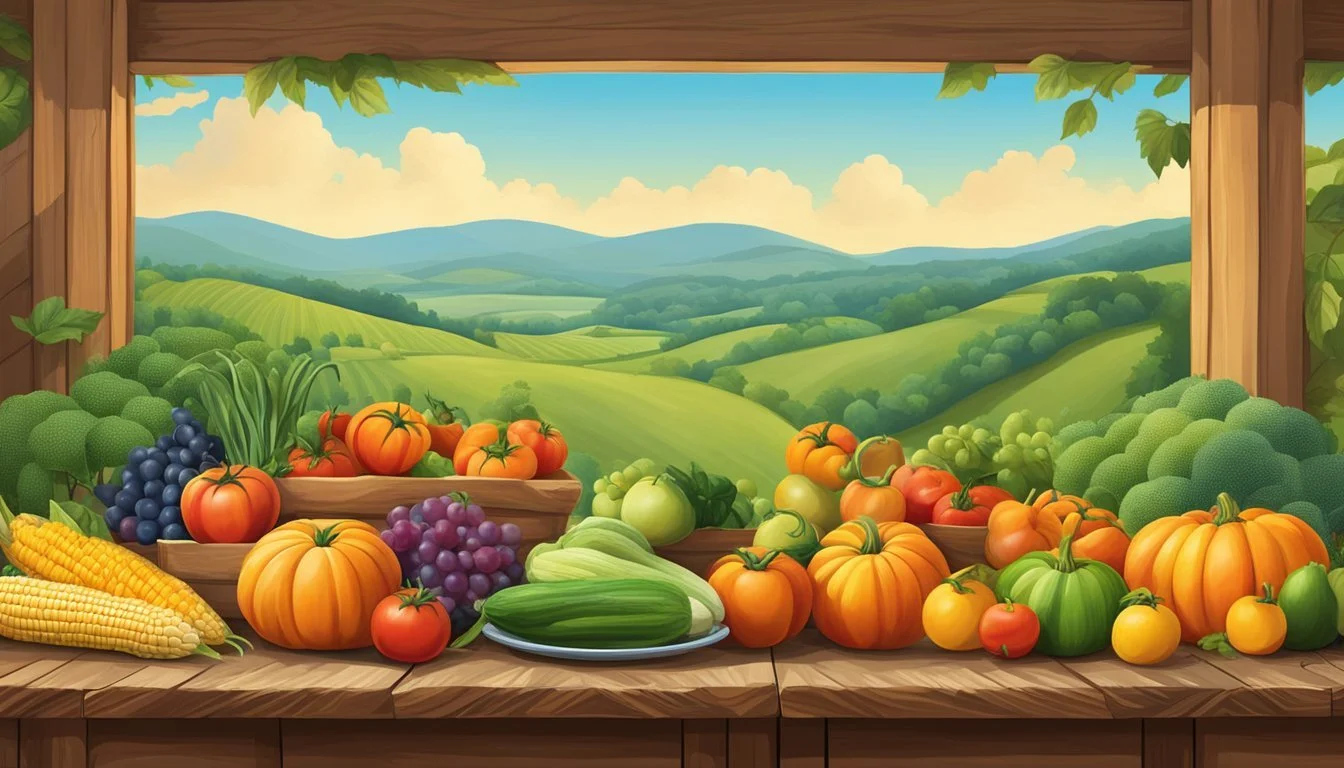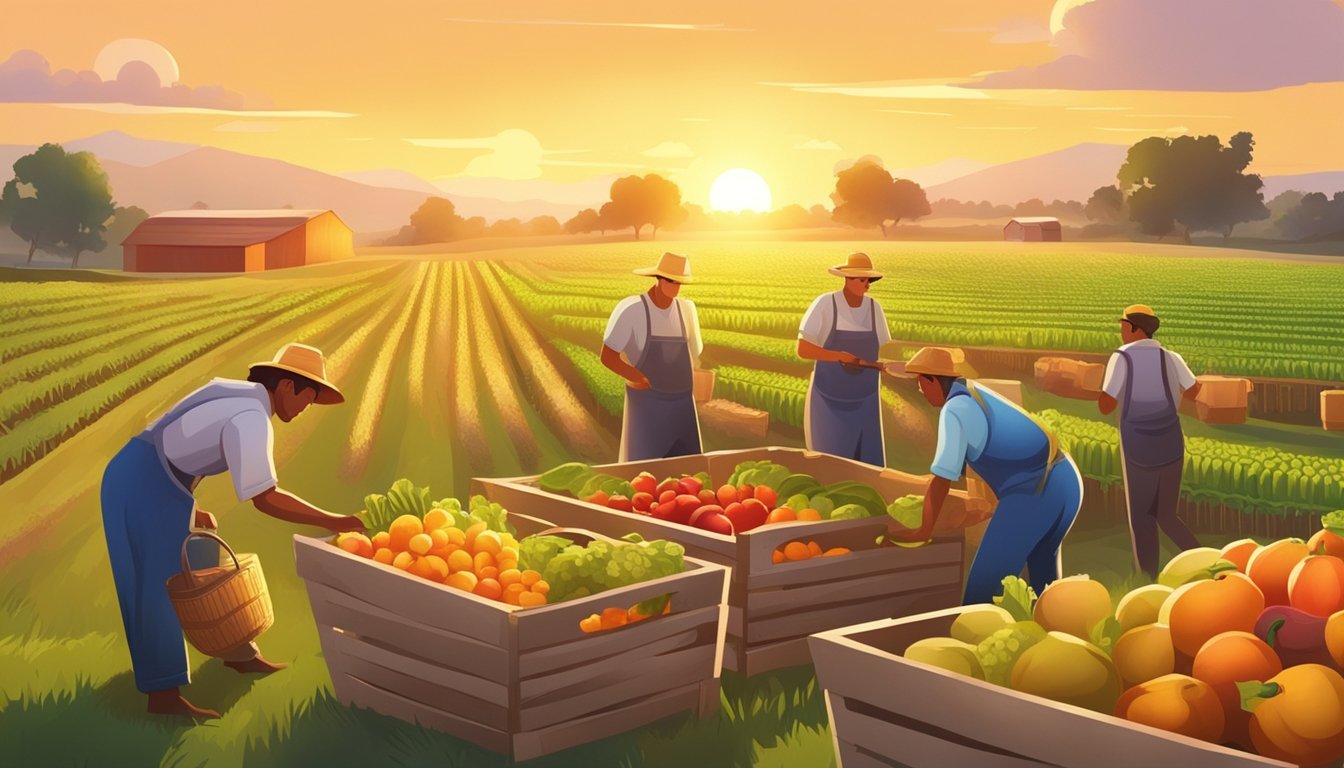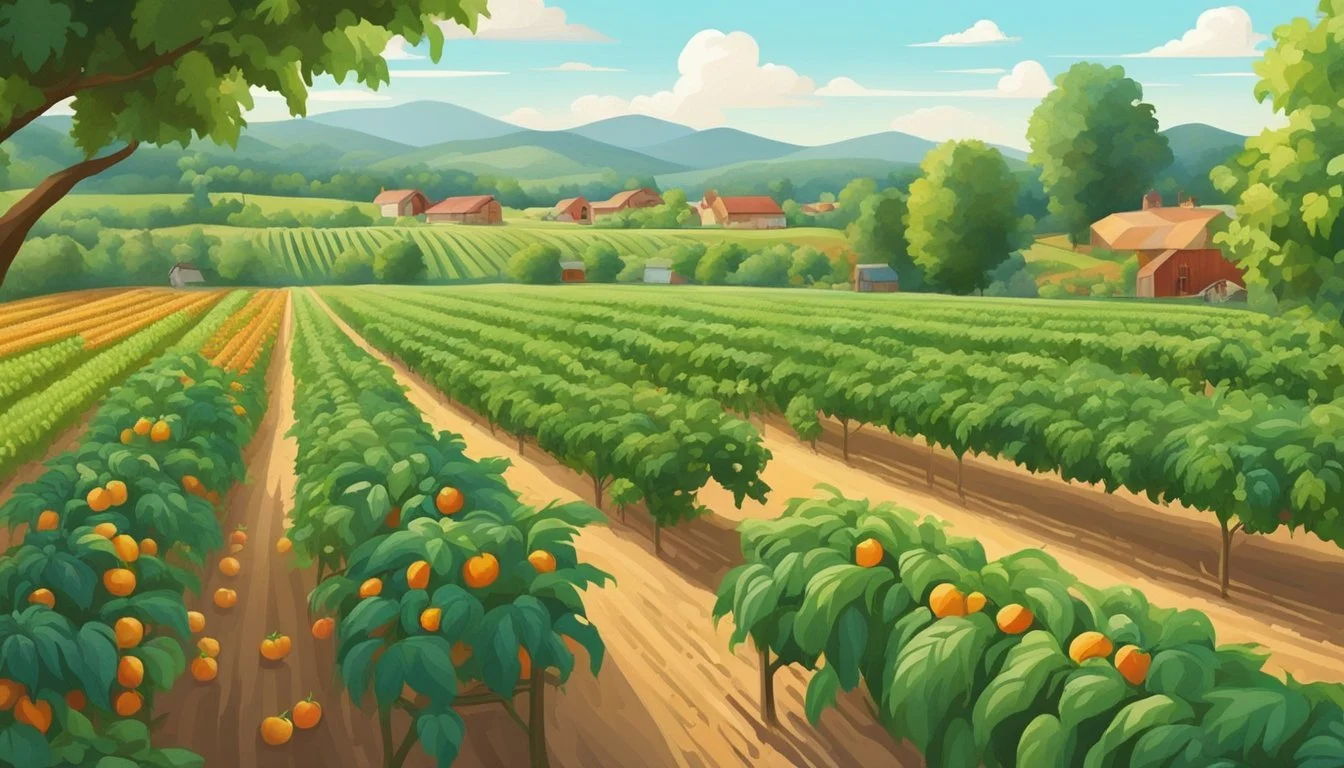Oklahoma Seasonal Fruit & Veg Guide
Your Comprehensive Resource
The farm-to-table movement in Oklahoma is a thriving and integral part of the state's culinary identity, intertwining the concept of eating fresh produce with the support of local farmers. In Oklahoma, the connection between the harvest and the dining table is celebrated, as the availability of seasonal fruits and vegetables influences not only the menus of local restaurants but also the eating habits of consumers who seek nutrient-dense and fresh ingredients. The state's diverse agricultural offerings provide a bounty of seasonal produce, which varies throughout the year and is embraced by both chefs and home cooks for its peak flavor and nutritional value.
Navigating through Oklahoma’s produce calendar, consumers and restaurateurs alike find that the timing of when fruits (What wine goes well with fruit?) and vegetables are at their best is crucial. For instance, apples, widely available in grocery stores year-round, are actually in season in Oklahoma from July to October. Understanding such seasonality helps in planning meals and contributes to the state's farm-to-table approach, which not only elevates the dining experience but also bolsters the local economy and ensures a market for small-scale farmers.
This guide to seasonal fruits and vegetables in Oklahoma is a resource intended to assist anyone interested in making the most of the region's rich agricultural offerings. It not only encourages the consumption of goods when they are at their freshest but also underlines the importance of community support for local food systems. By aligning food choices with what's available each season, Oklahomans can enjoy a variety of fresh flavors while contributing to the sustainability and resilience of local farms.
What’s in Season in Oklahoma Right Now?
Benefits of Farm to Table
The farm-to-table movement in Oklahoma garners appreciation for its role in bolstering the local economy, ensuring the consumption of fresh and nutritious produce, and promoting positive environmental practices.
Supporting Local Economy
When consumers choose farm-to-table options, they are investing directly in their local economy. Local farms in Oklahoma see an increase in demand which leads to job creation and supports the financial stability of rural communities. By reducing the reliance on imported goods, the money circulates within the state, strengthening Oklahoma's overall economic health.
Increased Demand: Direct support for local farmers
Economic Circulation: Monetary support stays within Oklahoma
Freshness and Nutrition
Farm-to-table produce is acclaimed for its freshness, often harvested at the peak of ripeness. This results in fruits and vegetables that are not only more flavorful but also pack a higher nutritional value. Fresh produce contains higher levels of vitamins, minerals, and antioxidants, which are essential for a healthy diet.
Peak Ripeness: Enhanced flavor profiles
High Nutritional Value: Maximized benefits for a healthy lifestyle
Environmental Impact
Local farm-to-table practices have a reduced carbon footprint compared to traditional agriculture methods that involve long-distance transportation. By minimizing transport, there is a significant decrease in greenhouse gas emissions. Additionally, sustainable farming techniques often used by local farms in Oklahoma contribute to soil health and biodiversity.
Reduced Carbon Footprint: Less transportation required
Sustainable Practices: Contribution to soil conservation and biodiversity
Understanding Oklahoma's Seasons
In Oklahoma, the seasonal climate significantly influences the types of fruits and vegetables that thrive throughout the year. This guide details what crops are typically harvested in each season, providing insights into the state's farm to table offerings.
Spring Harvest
Spring in Oklahoma is marked by the emergence of early greens and hearty root vegetables. March sees the arrival of asparagus and spinach, with radishes and carrots typically following in April. These months also usher in lettuce varieties, laying the groundwork for the salad season.
Summer Bounty
Summer brings an abundance of warmth and sunlight, crucial for many garden staples. Vegetables like tomatoes, sweet corn, and summer squash start becoming available around June. By July, Oklahomans enjoy a rich selection of cucumbers (how long do cucumbers last?), eggplant, okra, and cantaloupe (how long does cantaloupe last?). The summer heat also peaks the season for watermelon, a favorite for its refreshing taste.
Fall Crops
As the heat of summer wanes, fall crops take center stage. Pumpkins and winter squash become ready for harvest, signaling the onset of the festive season. This time is also ripe for picking various types of apples, available between July and October. Hardy vegetables such as broccoli, cauliflower, and cabbage also make their appearance, alongside root vegetables like beets and turnips.
Winter Offerings
Winter in Oklahoma can be challenging for fresh produce, yet certain hardy vegetables manage to persist. Growers harvest kale and spinach that can withstand cold conditions. Additionally, storage of crops such as onions and carrots allows them to be available even during the colder months, ensuring a continuous supply of some fresh produce.
Planning and Planting
Effective garden planning and planting are crucial for a bountiful harvest in Oklahoma. Gardeners should consider plant variety selection, soil preparation, watering needs, and the planting calendar tailored to local conditions for optimum yield.
Choosing the Right Varieties
When selecting fruit and vegetable varieties for an Oklahoma garden, one must opt for types that are adapted to the state’s climatic conditions. Local extensions or experienced gardeners can recommend cultivars known for their ability to thrive in Oklahoma’s weather patterns which include hot summers and variable winters.
Soil and Water Needs
The success of any Oklahoma garden hinges on the quality of its soil and water supply. Ideal gardening soil should be well-draining yet moisture-retentive, and rich in organic matter. Regular soil testing can guide fertilization for optimal plant growth. When it comes to watering, implementing a drip irrigation system or using mulch can efficiently maintain soil moisture and reduce water usage.
Planting Schedules
Planting times in Oklahoma vary by vegetable:
Cool-season vegetables such as cabbage should be planted between February 15 and March 10.
Warm-season vegetables are best planted when the soil has warmed to at least 60°F, typically after the last frost in spring.
A schedule for planting should be guided by the average first and last frost dates and adjusted for microclimates.
Pest and Weed Management
To protect Oklahoma gardens from pests and weeds, gardeners should employ integrated pest management (IPM) strategies. These might include crop rotation, use of natural predators, and barriers. Regular monitoring and prompt removal of weeds can prevent competition for nutrients and sunlight, essential for a healthy garden.
Harvesting and Storage
Successful farm to table initiatives in Oklahoma emphasize the critical timing of picking and gathering fruits and vegetables, along with maintaining their freshness through proper storage practices right after the harvest.
Picking and Gathering
One should harvest produce during the cooler parts of the day, ideally in the early morning, to reduce field heat. Containers used for gathering should be sturdy yet gentle on the produce to prevent bruising. Harvesting tools must be clean and sharp to ensure a clean cut, which helps prolong shelf-life and maintain quality.
Vegetables: Harvest when they are at peak maturity; not overly ripe.
Fruits: Pick when they show full color and are slightly firm to the touch.
Proper Storage Practices
After harvesting, fruits and vegetables should be placed in a cooler as soon as possible to remove field heat and slow down deterioration. Storage conditions vary for different types of produce, but they generally require a cool, dry environment.
Temperature: Maintain specific temperatures for different produce types, typically between 32°F to 55°F.
Humidity: Keep relative humidity high for most vegetables, around 85% to 95%, to prevent wilting.
Air Circulation: Ensure good air circulation around storage containers to avoid mold or spoilage.
A quick reference table for a few common produce items:
Produce Ideal Temp (°F) Ideal Humidity (%) Storage Life Apples 32-36 90-95 2-4 months Peaches 32-35 85-90 2-4 weeks Tomatoes 55-60 85-95 1-2 weeks Leafy Greens 32-36 90-95 1-2 weeks
It's important to keep these practices consistent to deliver the freshest produce from Oklahoma farms directly to the table.
Enjoying the Harvest
Oklahoma's seasons bring an abundance of fresh fruits and vegetables, perfect for creating healthy, flavorful meals. As the harvest comes in, one can relish the peak freshness of these local yields, transforming them into delightful dishes and preserving their goodness for later enjoyment.
Preparing Fresh Meals
Fresh Produce: The heart of farm-to-table cooking is the use of fresh, seasonal produce. In Oklahoma, the summer months overflow with ripe tomatoes, peppers, cucumbers, squash, and other garden favorites. Utilize these ingredients in recipes that highlight their natural flavors. For instance, a ripe tomato is excellent for a vibrant gazpacho or a caprese salad, while crisp cucumbers can be transformed into refreshing salads or chilled soups.
Recipes: When preparing meals, consider recipes that let the freshness of the produce shine. Cooking methods such as grilling or roasting can enhance the natural sweetness of vegetables, and incorporating herbs can complement the flavors without overpowering them. For fruits, less is often more; a simple berry salad or a peach crisp allows the natural taste to be the star.
Preservation and Canning
Preserving the bounty ensures that the flavors of the season last far beyond their harvest. Canning vegetables like okra, tomatoes, and cucumbers can be done through various methods, including pickling or making relishes and sauces.
Pickling: This method is great for extending the life of cucumbers and peppers. It involves creating a vinegar-based brine and canning the vegetables to create pickles or pepper mixes that can be enjoyed for months.
Canning Fruit: For fruits, creating jams, jellies, or whole canned fruits can capture the essence of summer. When making a jam, using a small amount of sugar will allow the natural sweetness of the fruit to dominate.
By engaging in these practices, one can enjoy Oklahoma's farm-to-table produce throughout the year, with the confidence of having nutrient-dense and delicious preparations at hand.
Connecting with Local Farmers
In Oklahoma, establishing a relationship with local farmers enriches the community and ensures access to fresh, seasonal produce. Here are some of the most effective ways to connect with those who cultivate the land.
Farmer's Markets and CSAs
Oklahoma's Farmer's Markets are vital hubs where consumers can meet and support local farmers. These markets provide an array of seasonal fruits and vegetables, with opportunities for consumers to ask questions about the produce and farming practices. Community Supported Agriculture (CSA) programs allow individuals to subscribe to the harvest of specific farms like Maple Creek Berry Farm and Creekside Berry Farm, receiving regular deliveries of fresh produce.
Farm Visits and Tours
Many Oklahoma Farms offer farm visits and tours which enable individuals to personally connect with the land and the people who work it. This firsthand experience often translates into a greater appreciation of the produce. Farms like Buffalo Creek Berry Farm and Wind Drift Orchards welcome the public to explore their fields and sometimes even participate in the harvest.
Online Communities
Online platforms provide a digital space for consumers to engage with farmers. Facebook groups dedicated to Oklahoma Farm to Table endeavors connect users with local food sources, farmers, and markets. These communities enforce strict rules to ensure that all products are local, fostering a trustworthy environment for both consumers and producers.







